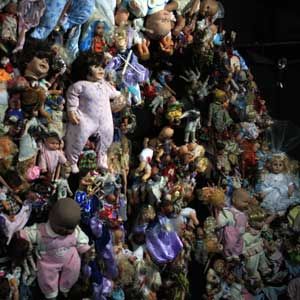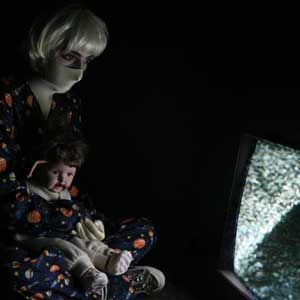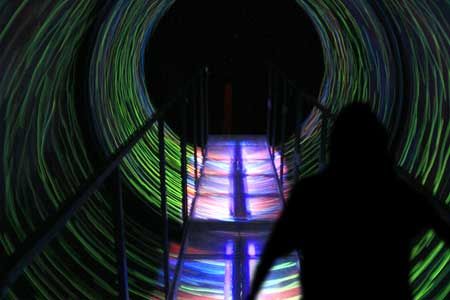Are you ready to transform your home into the talk of the neighborhood this Halloween? Forget the simple jack-o’-lantern on the porch. Elevate your space into a spine-chilling haunted house attraction that will leave trick-or-treaters and thrill-seekers trembling with excitement.
Whether you’re planning to convert your entire home or just your basement, we’ll guide you through creating a memorable and frightening experience. This guide will help you craft a haunted house that’s the talk of the neighborhood.
Essential Elements of a Haunted House
Creating a truly terrifying haunted house requires components that work together to build tension, create disorientation, and ultimately deliver scares that will leave a lasting impression on guests.
Twists and Turns
A winding path through your haunted house builds fun suspense. Timothy Haskell, creator of a popular New York City haunted house, emphasizes the value of anticipation, stating, “People always fear what lurks around the corner.” By designing a layout with numerous turns and hidden areas, you keep visitors on edge, never knowing what might be waiting for them next.
Lighting Techniques
Lighting plays a big role in setting the mood and creating an unsettling atmosphere. Everything is scarier in the dark. Use a combination of dim lighting and strategic shadows to hide potential scares and keep visitors guessing.
Use strobe lights to disorient and confuse your guests. Haskell adds, “Everything is more distorted and thus more menacing when you can’t get a clean look at it because the strobe lights are skewing your vision.”
Sound Effects
Auditory stimulation is a powerful tool in your haunted house arsenal. Eerie background music, sudden loud noises, and subtle, unsettling sounds contribute to a heightened sense of fear. Consider using a mix of ambient sounds such as creaking floorboards, distant screams, or whispered voices to keep visitors on edge throughout their experience.
Atmosphere
Fog machines or dry ice can create a ghostly atmosphere, especially when used around the entrance or in graveyard scenes. Stretch fake spider web material across doorways, windows, and corners. Add plastic spiders for extra creepiness. Decorate the entrance with overgrown vines, fog, and a sign with a chilling warning. Consider using a curtain or door that visitors must push through.
Creating Memorable Scares in Your Home
While the overall atmosphere is important, it’s the specific scares that visitors remember long after they’ve left. Here are some examples.
Sensory Stimulation
To create a multi-sensory experience, you need to engage more than just the visitors’ eyes. Haskell stresses engaging multiple senses: “Don’t just assault the eyes. Explore ways for people to hear, smell, feel, and even taste the experience.”

Haskell suggests, “If you put someone in a dark room with the sound of scurrying rats, the smell of a damp basement, and some wiry little tails stuck to the walls at ankle length to simulate what feels like a rat, as far as they are concerned, there is a rat in there with them.” Combining these sensory elements makes the illusion stronger and the scare more effective.
Create creepy boxes with holes in them where visitors can feel “gross” items such as peeled grapes (eyeballs), cold spaghetti (worms), or damp sponges (brains).
Unexpected Surprises
The element of surprise breaks routines and expectations, keeping your visitors on their toes. Incorporate hidden actors, moving props, or sudden sound effects to catch them off guard. Use motorized or pressure-activated props that move or make noise when triggered.
Remember that timing is key. A well-timed scare can be far more effective than a constant barrage of frights. Properly timed surprises ensure that visitors experience a roller-coaster of emotions, balancing tense moments with highly thrilling scares.
Themed Rooms and Vignettes for DIY Haunted Houses
Creating themed areas within your haunted house helps tell a cohesive story and provides varied scares for your visitors.
Creepy Clown Corner
Haskell notes, “For some reason, everyone is terrified of these guys. Stick them in a room with some twisted circus music and no one wants to go in.” Create a carnival-gone-wrong atmosphere with distorted funhouse mirrors, eerie calliope music, and of course, plenty of sinister clowns lurking in the shadows.
Doll Room Nightmare
Dolls have an inherently unsettling quality you can use in your haunted house. Set up a room filled with old, worn dolls of various sizes. Use dim, flickering lighting to create moving shadows, and consider having some dolls that can move or make sounds unexpectedly.

Rat-Infested Basement
Create a multi-sensory experience of a decrepit, rat-infested basement. Use the technique Haskell described earlier, combining darkness, scurrying sounds, musty smells, and tactile elements to convince visitors they’re surrounded by rodents.
Horror Show
Use mannequin parts, rubber gloves filled with stuffing, or fake severed limbs to create the illusion of dismembered bodies.
Safety Considerations for DIY Haunted Houses
While creating a terrifying experience is the goal, your guests’ safety should always be your top priority. A great haunted house keeps your scares memorable and avoids any real-life horrors.
Avoiding Trip Hazards
Keep all walkways clear and free from potential tripping hazards, such as extension cords. If you have uneven surfaces, use ramps or glow-in-the-dark tape to mark steps to prevent accidents.
Fire Prevention
Avoid using open flames or heat-generating items to avoid fire risks. Opt for LED candles and lights instead of real ones, and ensure all your electrical equipment is in good working order.
Clear Exit Strategies
While hidden exits might seem to add to the scare factor, they’re dangerous in emergencies. Clearly mark all exits and keep them easily accessible. We recommend glow-in-the-dark paint or signs to make exits visible even in low-light conditions.
Supervision
Designate someone to keep an eye on the experience as a whole. The goal is to scare, not to harm. Have someone ready to help those who get turned around and can’t find their way out. Make sure that everyone who enters comes out, especially children. This person should ensure no one brings in anything that could cause a fire or be used to harm live actors.

